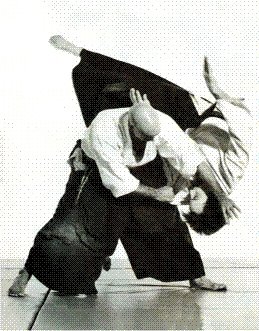 El profesor Peter Goldsbury nos ofrece una serie de columnas sobre tres aspectos muy importantes del Aikido -la transmisión, la herencia y la emulación- en Aikiweb. Estos son los enlaces a los originales en inglés:
El profesor Peter Goldsbury nos ofrece una serie de columnas sobre tres aspectos muy importantes del Aikido -la transmisión, la herencia y la emulación- en Aikiweb. Estos son los enlaces a los originales en inglés:
- Transmission, Inheritance, Emulation (I).
- Transmission, Inheritance, Emulation (II).
- Transmission, Inheritance, Emulation (III).
- Transmission, Inheritance, Emulation (IV).
- Transmission, Inheritance, Emulation (V).
- Transmission, Inheritance, Emulation (VI).
Interlude I: The General Impact of the Pacific War (World War II) on Aikido. - Transmission, Inheritance, Emulation (VII).
Interlude II: Budo and Bushido, Kami and Kokutai: Aikido, Religion & Nationalism. - Transmission, Inheritance, Emulation (VIII).
Interlude III: Deguchi, Ueshiba and Omoto. Part 1: The First Suppression. - Transmission, Inheritance, Emulation (IX).
Interlude III: Deguchi, Ueshiba and Omoto. Part 2: The Second Suppression. - Transmission, Inheritance, Emulation (X).
Interlude IV: Iemoto and Iwama. - Transmission, Inheritance, Emulation (XI).
Interlude V: The Danger of Words or, The Elephant in the Dojo: Distinguishing the Jumbo from the Mumbo. Part 1: Morihei Ueshiba's Elephant. - Transmission, Inheritance, Emulation (XII).
Interlude V: The Danger of Words or, The Elephant in the Dojo: Distinguishing the Jumbo from the Mumbo. Part 2: Ueshiba's Elephant and the Rest of the Herd. - Transmission, Inheritance, Emulation (XIII).
Interlude VI: The Question of Kotodama. Part 1: Preliminaries. Kukai (Kobo Daishi) and the Man'yoshu. - Transmission, Inheritance, Emulation (XIV).
Interlude VI: The Question of Kotodama. Part 2: Kotodama becomes Japanese. From Motoori Norinaga to World War II. - Transmission, Inheritance, Emulation (XV).
Interlude VI: The Question of Kotodama. Part 3: Postwar Resurrection. Back to Morihei Ueshiba's Elephant. - Transmission, Inheritance, Emulation (XVI).
Interlude VII: Hidden in Plain Sight. Tracing the Roots of Ueshiba Morihei's Power by Ellis Amdur. A Review Essay. Part 1: Chinese Influence and the Beginnings of Daito Ryu. - Transmission, Inheritance, Emulation (XVII).
Interlude VII: Hidden in Plain Sight. Tracing the Roots of Ueshiba Morihei's Power by Ellis Amdur. A Review Essay. Part 2: Takeda Sokaku in his Historical & Cultural Context.
Peter Goldsbury (b. 28 April 1944). Aikido 6th dan Aikikai, Professor at Hiroshima University, teaching philosophy and comparative culture. B. in UK. Began aikido as a student and practiced at various dojo. Became a student of Mitsunari Kanai at the New England Aikikai in 1973. After moving back to the UK in 1975, trained in the Ryushinkan Dojo under Minoru Kanetsuka. Also trained with K Chiba on his frequent visits to the UK. Moved to Hiroshima, Japan, in 1980 and continued training with the resident Shihan, Mazakazu Kitahira, 7th dan Also trained regularly with Seigo Yamaguchi, Hiroshi Tada, Sadateru Arikawa and Masatake Fujita, both in Hiroshima and at the Aikikai Hombu. Was elected Chairman of the IAF in 1998. With two German colleagues, opened a small dojo in Higashi-Hiroshima City in 2001. Instructed at Aiki Expo 2002 in Las Vegas, Nevada.
NOTA (20/02/2009): Editado para añadir "Transmission, Inheritance, Emulation (XI)".
NOTA (20/03/2009): Editado para añadir "Transmission, Inheritance, Emulation (XII)".
NOTA (18/06/2009): Editado para añadir "Transmission, Inheritance, Emulation (XIII)".
NOTA (24/07/2009): Editado para añadir "Transmission, Inheritance, Emulation (XIV)".
NOTA (20/08/2009): Editado para añadir "Transmission, Inheritance, Emulation (XV)".
NOTA (16/12/2009): Editado para añadir "Transmission, Inheritance, Emulation (XVI)".
NOTA (16/02/2010): Editado para añadir "Transmission, Inheritance, Emulation (XVII)".

 The Art of Aiki es la más completa fuente de información sobre el Aikido en Español. |
The Art of Aiki es la más completa fuente de información sobre el Aikido en Español. |